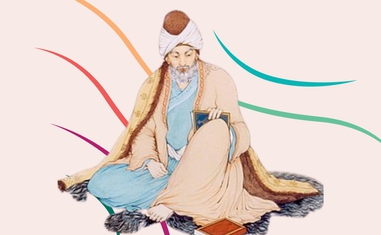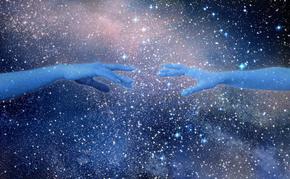The views expressed in our content reflect individual perspectives and do not represent the authoritative views of the Baha'i Faith.
Rumi – the 13th century Sufi mystic and poet – is a good place to start a spiritual journey, while asking the profound question, “How deep does our shared oneness go?” This Rumi poem explains:
Only Breath
Not Christian or Jew or Muslim,
not Hindu, Buddhist, sufi, or zen.
Not any religion or cultural system.
I am not from the East
or the West,
not out of the ocean
or up from the ground,
not natural or ethereal, not composed of elements at all.
I do not exist,
am not an entity in this world or the next,
did not descend from Adam and Eve
or any origin story.
My place is the placeless,
a trace of the traceless.
Neither body or soul.
I belong to the beloved,
have seen the two worlds as one
and that one call to and know,
first, last, outer, inner, only that
breath breathing human being.
RELATED: Rumi, Romantic Love and Reunion with the Beloved
In this YouTube video Rumi’s poem “Only Breath” is re-presented by poet and translator Coleman Barks, taking us deeper into what and who we truly are.
Interestingly, throughout the Baha’i writings Baha’u’llah and Abdu’l-Baha quote Rumi many times. The author Arjen Bolhuis has so far found more than thirty examples here.
Rumi wrote from a Sufi perspective, but parallel teachings from many other traditions also nurture our realization in inter-spiritually derived oneness. As the Baha’i teachings affirm, there is one God, One Holy Spirit, and one unending series of prophets and messengers to guide humanity.
All of those spiritual teachers teach similar core themes.
We are citizens of two realms – the material and the spiritual. Spiritual practices such as meditation and prayer enable self-knowledge. We are fed by wisdom from “the changeless faith of God.” When we absorb that wisdom and translate it into action, gradually egotistic tendencies diminish. Our mystic heart expands with more moments of ineffable union in this world and the non-dual worlds. Eventually the two become one.
From the teachings of Baha’u’llah, the prophet and founder of the Baha’i Faith, we read:
The purpose of God in creating man hath been, and will ever be, to enable him to know his Creator and to attain His Presence. To this most excellent aim, this supreme objective, all the heavenly Books and the divinely-revealed and weighty Scriptures unequivocally bear witness. Whoso hath recognized the Day Spring of Divine guidance and entered His holy court hath drawn nigh unto God and attained His Presence, a Presence which is the real Paradise.
Baha’u’llah’s son and successor Abdu’l-Baha said that “… all parts of the creational world are of one whole,” but also “God contains all …. The whole is greater than its parts …” On change and changelessness, Abdu’l-Baha said:
Time changes conditions, and laws change to suit conditions. We must remember that these changing laws are not the essentials; they are the accidentals of religion.
The essential ordinances established by a Manifestation of God are spiritual; they concern moralities, the ethical development of man and faith in God. They are ideal and necessarily permanent – expressions of the one foundation and not amenable to change or transformation.
Every major Faith includes these mystical elements. Taoism, for example, sums up the most important themes from the first chapter of the Tao Te Ching:
The tao that can be told is not the eternal Tao. The name that can be named is not the eternal Name. The unnamable is the eternally real. Naming is the origin of all particular things. Free from desire, you realize the mystery. Caught in desire, you see only the manifestations. Yet mystery and manifestations arise from the same source.
The Hindu teachings offer similar spiritual insights, as in this translation of a Vedantic hymn by Swami Prabhavananda:
Like two birds of golden plumage, inseparable companions, the individual self and the immortal Self are perched on the branches of the self same tree. The former tastes of the sweet and bitter fruits of the tree; the latter, tasting of neither, calmly observes.
The individual self, deluded by forgetfulness of his identity with the divine Self, bewildered by his ego, grieves and is sad. But when he recognizes the worshipful Lord as his own true Self, and beholds his glory, he grieves no more.
In his book Man Is Not Alone: A Philosophy of Religion, the great Jewish teacher and activist Rebbe Abraham Joshua Heschel described these two worlds exquisitely:
The Search for reason ends at the known; on the immense expanse beyond it only the sense of the ineffable can glide. It alone knows the route to that which is remote from experience and understanding.
Neither of them is amphibious: reason cannot go beyond the shore, and the sense of the ineffable is out of place where we measure, where we weigh.
We do not leave the shore of the known in search of adventure or suspense or because of the failure of reason to answer our questions. We sail because our mind is like a fantastic seashell, and when applying our ear to its lips we hear a perpetual murmur from the waves beyond the shore.
Citizens of two realms, we all must sustain a dual allegiance: we sense the ineffable in one realm, we name and exploit reality in another. Between the two we set up a system of references, but we can never fill the gap.
They are as far and as close to each other as time and calendar, as violin and melody, as life and what lies beyond the last breath.
This ancient Zen Buddhist teaching, which the great Zen master Dogen taught, proclaims:
To study the Buddha Way is to study the self, to study the self is to forget the self, and to forget the self is to be enlightened by the ten thousand things. … To be enlightened by the 10,000 things is to recognize the unity of the self and the 10,000 things.
RELATED: The Mystery of Progressive Revelation
The work of Christian author and scholar Tim Redfern, in particular his article “That God may be all in all: Christianity and Nonduality” informs us about these core themes and their primacy in Christianity:
The basis for these claims about “nondual Christianity” lies in the New Testament, salvation is frequently displayed as a process of unification and becoming One.
In the Fourth Gospel, Jesus prays “that they may all be one, as thou, Father, art one in me, and I in You, that they may be one in Us” [John 17:21].
In his Second Epistle, Peter writes that through the promises of Christ we will become “partakers of the divine nature” [1 Peter 1:4], a passage usually cited as the basis for the doctrine of deification.
John, in his First Epistle, writes “when Christ appears, we shall be like him, for we shall see him as he is” [1 John 3:2], and when this happens…
Paul tells us, “we will all, beholding the glory of the Lord, be changed into his likeness, from glory to glory” [2 Cor 3:18] and God will be “all in all” [1 Cor 15:28].
According to Paul, “as many of you who were baptised into Christ have clothed yourselves with Christ. There is no longer Jew or Greek, slave or free, male or female: for all are one in Christ Jesus” [Gal 3:27–28].
In this vision, individual identities seem to fall away; as elsewhere, incorporation into Christ is depicted as a unifying process that transforms the creature into ‘part’ of the Creator: “you are Christ’s body, and each of you is a part of it” [1 Cor 12:27].
There is clearly a strong current within Christian theology that views union with God as the ultimate spiritual destination…. and the priority of unio mystica in contemplative mysticism — literally “oneing,” as Julian of Norwich (1343–1416) called it.
So How Deep Does Our Oneness Go?
The teachings shared here all show the true heart of the core themes of religion. We can find a short version of those insights in this striking definition of Namaste, the traditional Hindu greeting which loosely means “salutations to the divine child in your heart:”
“I honor the place in you
in which the entire Universe dwells.
I honor the place in you which is of Love,
of Integrity, of Wisdom and of Peace.
When you are in that place in you,
and I am in that place in me,
we are One.”
Baha’u’llah wrote; “Meditate on what the poet hath written, “Wonder not, if my Best-Beloved be closer to me than mine own self.”
When we ponder that single line, we address the most mystical depths of our selves.

















Comments
Sign in or create an account
Continue with Facebookor